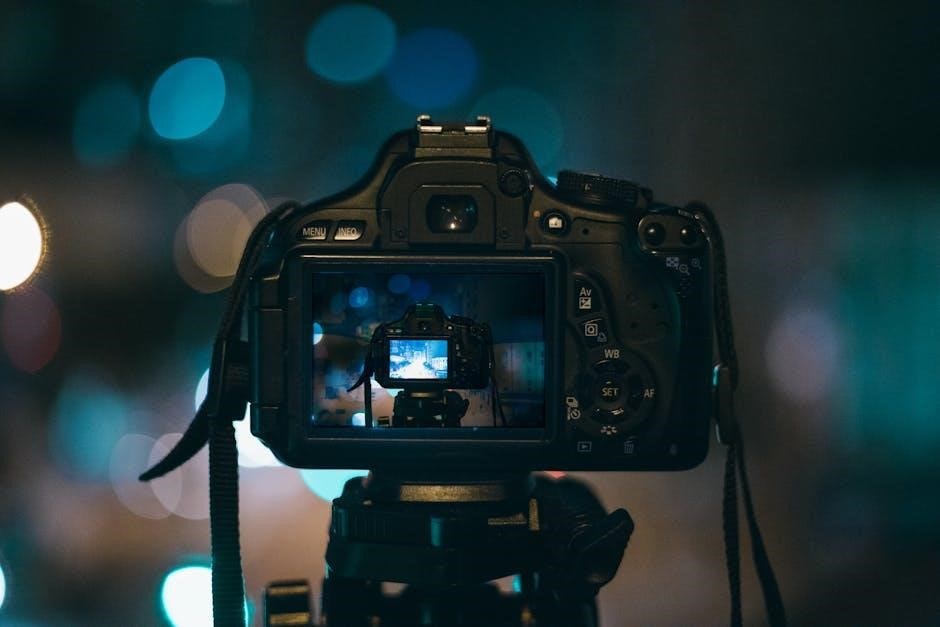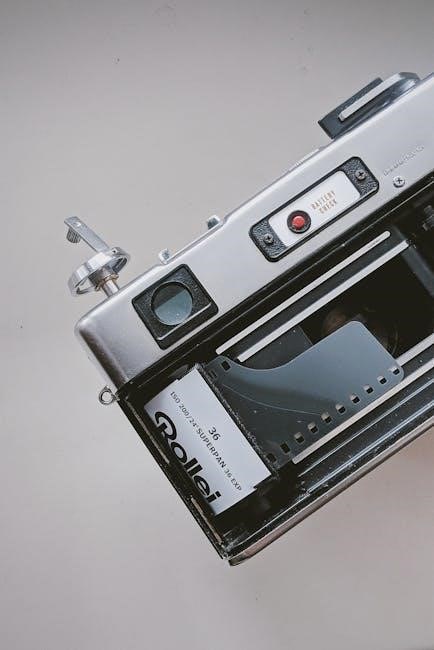Browning Trail Camera Manual: A Comprehensive Guide

Embark on your journey with Browning Trail Cameras‚ your trusted companion for capturing wildlife moments. This comprehensive guide helps you navigate your camera’s features. Learn how to set it up‚ maximize image quality‚ explore capture modes‚ and retrieve those precious images. This guide ensures a seamless experience in the field.
Finding Your Browning Trail Camera Manual
Locating the correct Browning Trail Camera manual is crucial for optimizing its performance. You can often find the model number inside the camera door or on a sticker at the back. With the model number identified‚ several avenues are available to secure your manual. The official Browning Trail Cameras website is a primary resource‚ offering downloadable PDFs for various models.
Manualslib.com is another excellent source‚ providing access to numerous Browning Trail Camera manuals like the Recon Force Elite HP5 BTC-7E-HP5. These digital manuals offer step-by-step instructions‚ troubleshooting tips‚ and detailed explanations of camera functions. Also‚ consider exploring online forums and communities where users often share links to manuals or provide assistance in locating specific models. Remember to verify the manual’s compatibility with your exact model for accurate guidance. Using the correct manual ensures you harness the full potential of your camera‚ capturing stunning wildlife moments.
Understanding Your Camera Model
Grasping the specifics of your Browning Trail Camera model is vital for effective use. Each model‚ such as the Strike Force BTC-5HD or Recon Force Elite HP5‚ has unique features and capabilities. Start by locating the model number‚ typically found inside the camera’s front door or on a sticker at the rear.
Refer to your manual to understand your camera’s capabilities‚ such as image resolution (e.g.‚ 4MP‚ 8MP‚ 12MP‚ 24MP)‚ video quality (1920×1080 resolution)‚ trigger speed‚ and detection range. Knowing these specs helps optimize settings for your specific needs‚ whether capturing detailed photos or high-definition videos. Different models offer varying capture modes‚ including trail cam‚ timelapse‚ and multi-shot options. Understanding these modes allows you to tailor the camera’s operation to different scenarios‚ ensuring you capture the best possible footage. Familiarize yourself with the camera’s physical layout‚ including button locations‚ battery installation‚ and SD card placement‚ to facilitate quick adjustments in the field. This knowledge empowers you to maximize your camera’s potential.
Quick Start Guide Overview
Begin your Browning Trail Camera experience with the quick start guide‚ your compass to immediate functionality. First‚ install 8 AA Alkaline batteries and an SD card‚ ensuring they meet the camera’s specifications; Power on the camera using the ON/OFF switch‚ typically found on the side or front.
Next‚ enter the programming screen by pressing the MODE button. This grants access to essential settings. Set the time and date accurately to ensure correct data imprinting on your images. Choose your desired capture mode – trail cam‚ video‚ or timelapse – based on your surveillance needs. Adjust photo and video quality settings to optimize clarity and storage capacity. Familiarize yourself with the main screen‚ which displays vital information: operation mode‚ shot count‚ SD card capacity‚ resolution‚ and battery life. The live image background aids in precise camera positioning. With these fundamental steps‚ your Browning Trail Camera is set for action‚ capturing the unseen world with ease.
Navigating the Programming Screen

The programming screen of your Browning Trail Camera is the central hub for customizing its functionality. Access it by pressing the MODE button‚ typically located on the front or side of the camera. Once entered‚ you’ll encounter a menu-driven interface‚ offering various settings and options. Use the UP and DOWN arrow keys to navigate through the menu items‚ highlighting your desired selection. Press the ENTER button to access the settings within each menu option. The screen displays the current settings for each parameter‚ allowing you to make informed adjustments.
Within the programming screen‚ you can configure capture modes‚ photo and video quality‚ time and date settings‚ and advanced features such as timelapse mode and multi-shot settings. The intuitive layout ensures ease of use. The screen provides real-time feedback‚ displaying the impact of your changes. Remember to press the ENTER button to save any modifications you make. Familiarizing yourself with the programming screen empowers you to tailor the Browning Trail Camera to your specific needs‚ maximizing its performance and capturing the optimal images and videos.
Setting Time and Date
Accurate time and date settings are crucial for effectively managing your Browning Trail Camera’s captured data. To set the time and date‚ first‚ access the programming screen by pressing the MODE button on your camera. Navigate through the menu options using the UP and DOWN arrow keys until you find the “SETUP DATE/TIME” option. Press the ENTER button to select this option and enter the time and date setting screen. Here‚ you’ll typically find separate fields for setting the month‚ day‚ year‚ hour‚ and minutes.
Use the UP and DOWN arrow keys to adjust each field to the correct value. Once you’ve set the desired value for a particular field‚ press the RIGHT arrow key to move to the next field. After setting all the fields to the correct time and date‚ press the ENTER button to save your changes. The camera will now display the accurate time and date on the image data strip‚ providing valuable context to your captured photos and videos. Remember to check and adjust these settings periodically‚ especially after battery changes or extended periods of inactivity‚ to ensure accurate data logging.

Capture Mode Options
Your Browning Trail Camera offers diverse capture mode options to suit various monitoring needs. Access these settings via the “OPERATION MODE” option in the SETUP MENU. The “TRAIL CAM” mode‚ ideal for game observation‚ captures photos or videos triggered by motion. “Timelapse” mode takes pictures at set intervals‚ perfect for observing gradual changes over time‚ such as field activity. You can also set up a “Timelapse Plus” mode for taking both timelapse and triggered images. For each mode‚ you can configure settings like image resolution and video length.
The “Video” mode captures video clips when motion is detected. This mode offers options for video resolution and clip length. These options are typically HIGH resolution capturing videos at 30 frames per second. The “Photo” mode captures still images when triggered. Consider using “Multi Shot” mode to capture several images in quick succession when the camera is triggered. This increases your chances of capturing the perfect shot of a fast-moving subject. Familiarize yourself with each mode to maximize your camera’s effectiveness.

Photo and Video Quality Settings
Optimizing your Browning Trail Camera’s photo and video quality is crucial for clear and detailed recordings. Access these settings within the “CAMERA SETUP” menu. For photos‚ choose from resolutions like LOW (4MP)‚ MEDIUM (8MP)‚ HIGH (12MP)‚ or ULTRA (24MP)‚ balancing image detail and storage space. Higher resolutions capture more detail but require more memory. For videos‚ you can typically select from resolutions‚ impacting clarity and file size. Consider the “Video Quality” settings‚ which may offer options for HIGH resolution capturing videos at 30 frames per second.
The “Smart IR Video” feature extends video recording during motion detection‚ up to 5 minutes. Adjusting these settings depends on your camera model. Experiment with different resolutions and settings to find the optimal balance for your specific environment and monitoring needs. Higher quality settings result in clearer images and videos‚ but they also consume more battery power and storage space on your SD card. Consider your priorities when making these adjustments.
Timelapse Mode Configuration
Unleash the power of your Browning Trail Camera’s timelapse mode; The timelapse mode is ideal for capturing long-term changes and activities in a specific area. To configure this mode‚ navigate to “CAMERA SETUP” and locate “TIMELAPSE FREQ” and “TIMELAPSE PERIOD.” “TIMELAPSE FREQ” lets you set the time interval between each photo taken. You can find options for FREQ 15 SECONDS.
“TIMELAPSE PERIOD” allows you to define the specific hours during which the camera will capture images. This setting is useful if you want to monitor activity only during daylight or specific times of the day. By customizing these settings‚ you can tailor your camera to capture events‚ like plant growth or construction progress. Remember to save your selections by pressing the “ENTER” button. Utilize the Buck Watch Timelapse Viewer software (available on the Browning Trail Cameras website) to review your footage.
Image Retrieval Methods
Once your Browning Trail Camera has faithfully recorded nature’s wonders‚ it’s time to retrieve those images. The most common method is to remove the SD card from the camera and insert it into your computer. Both PC and Mac computers are compatible with this method. Simply locate the SD card slot on your computer and insert the card. Your computer should recognize the card as a removable drive‚ allowing you to access the photos and videos stored on it.
Alternatively‚ some Browning Trail Camera models may offer a USB connection option. Connect the camera to your computer using a USB cable. Then access the images directly from the camera’s memory. For reviewing timelapse footage‚ consider using the Browning Buck Watch Timelapse Viewer software. This can be downloaded from their website. This software provides a user-friendly interface for compiling and viewing your timelapse sequences.
Warranty Information and Support
Your Browning Trail Camera comes with a one-year limited warranty. This warranty covers defects in workmanship and materials under normal use. During this period‚ Browning Trail Cameras will repair or replace the product with a new or refurbished unit. This is at their discretion. To initiate a warranty claim‚ it’s essential to retain your proof of purchase and contact Browning’s customer service team.
Browning provides comprehensive support for their trail cameras. Their customer service team can assist with operating the camera. They can also help with setup and troubleshooting. For additional resources‚ visit the Browning Trail Cameras website. There you can find FAQs‚ software downloads‚ and contact information. For optimal performance and longevity‚ it’s essential to follow the guidelines outlined in the manual. Proper care will ensure your camera continues capturing stunning wildlife moments for years to come.